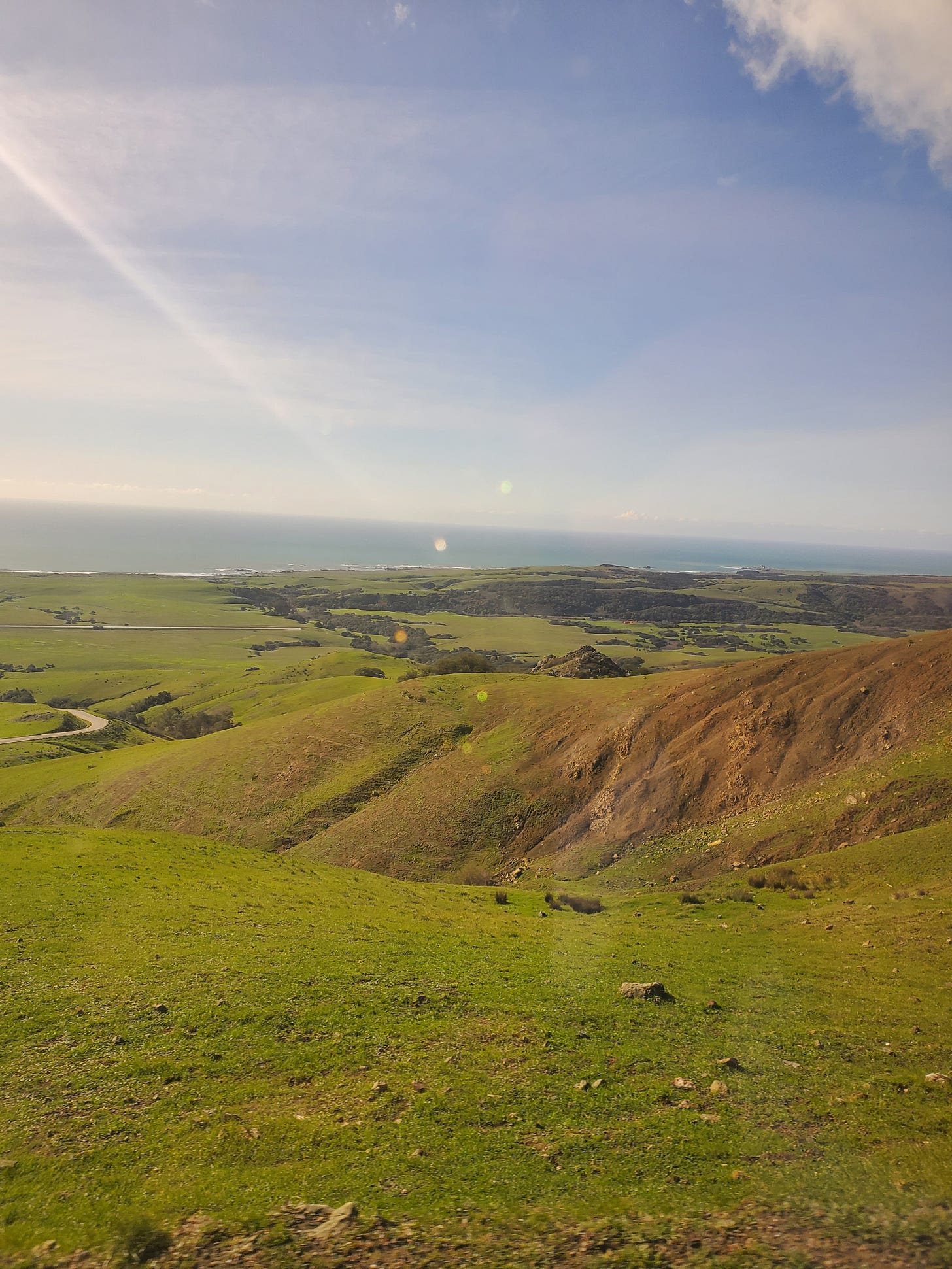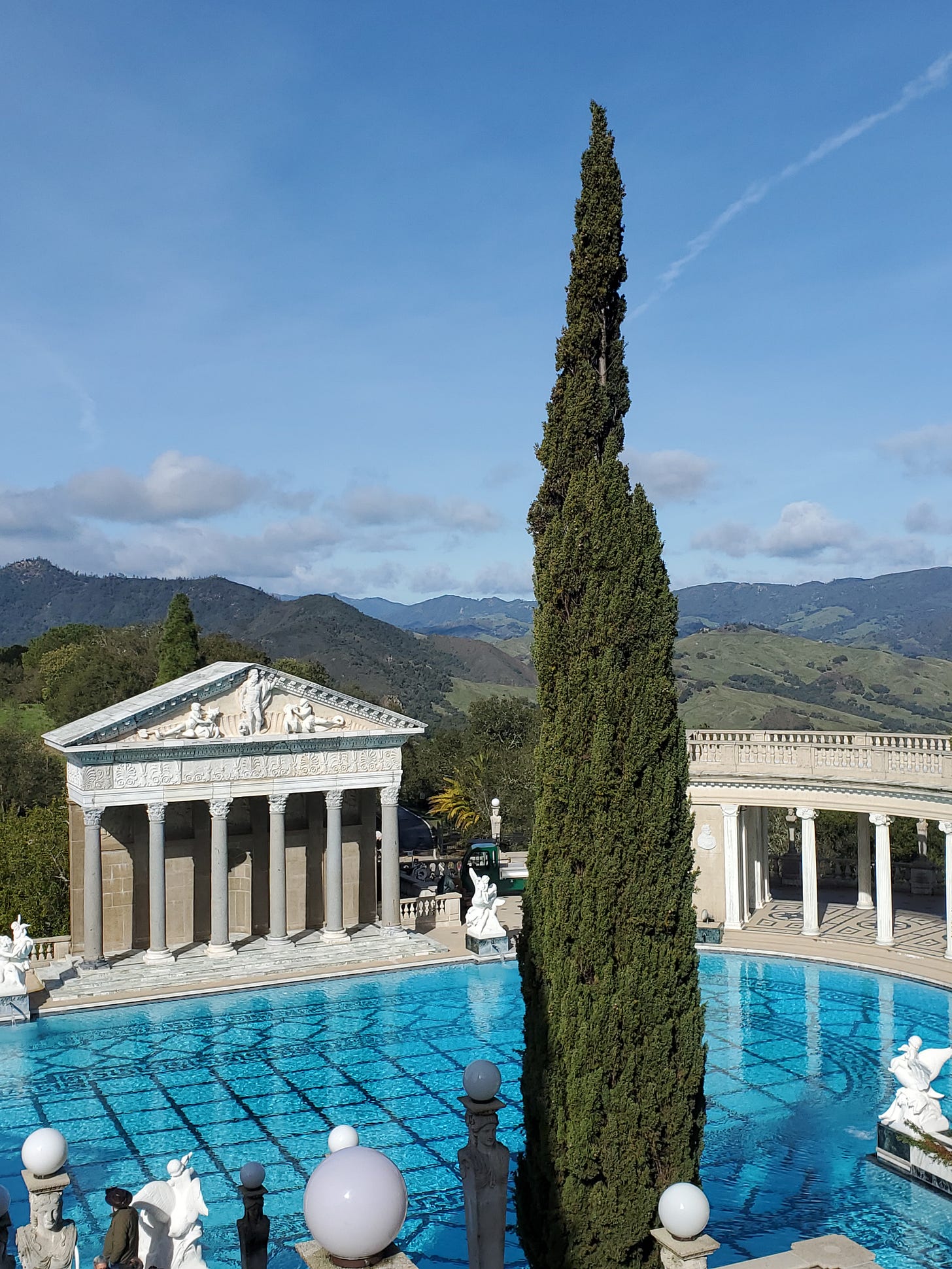If you ever visit Hearst Castle, and I sincerely hope you do, the last place they will take you to see on your tour will be the indoor swimming pool. It's unbelievably gorgeous, a luminescent body of water covered in dark blue and yellow tiles that refract the light back to the surface. It’s a truly magical place to look at, which it makes it all the more surprising that it sports quite literally the worst diving board of all time ever.
Worse than the ones you see over kidney-shaped pools in the suburbs. Worse than the ones in hotel pools in Mexico. Worse, and, if you can believe it, more dangerous, than the concrete diving stands you’ll see in old communist strongholds, all of which would kill you sooner than they’d make you strong. [1]
To begin, the board has no fulcrum. (That's the crank at one end that governs bounciness.) It also has no stand, but lies flat across the concrete. In other words, there is no drop. You could run straight off it on to the surface of the water…at least, if you were Jesus. But even if you consider it a platform of sorts - just an overhang over the pool, that is - it had a slightly upward tilt, which would make going off it extremely reckless.
Finally, and most importantly, the tour guide told us that guests often liked to jump off the second story balcony -- like all the dopey guests who have incurred catastrophic spinal injuries by doing cannonballs into countless motel pools while drunk, thus forever banning diving boards from hotels across America. But the pool depth was only 10 feet, which isn't regulation depth for such antics.
Like I said: Worst Board of All Time Ever. It made my calves hurt just looking at it. But in a way, that’s very apt. Of course it wasn't a regulation diving board, because this was Hearst Castle, and the presence of that jenky diving board hanging over the world's most beautiful pool was somehow the perfect metaphor for the whole misguided endeavor. It can tell you a lot about William Randolph Hearst, i.e. that he was rich but careless, like Tom & Daisy Buchanan, and also not unlike another nepo-baby who recently became President. Indeed, I bet you one billion bucks that if there's a diving board at Mar A Lago, it is equally unusable.
According to our guide, Hearst Castle is the number one most visited state park in California. I hadn't been there since I was small -- possibly my last visit was before the Patti Hearst kidnapping (and subsequent bombing of one of the rooms by an SLA sympathizer, whom suddenly, I sympathize with). All I remember of my first visit was the wild animals, who aren't there anymore, but besides that, I think the place is more or less unchanged. You can still see it’s white turrets high up on a mountain, looking exactly like a castle in a very young person’s dream; and when you get to the top of that mountain, you can look down the mountain at the untouched rolling hills of California and a vast expanse of the Pacific. The park service has seen that the area is entirely unspoiled; it's not going too far to say that it may be the most beautiful places on earth.
So, if you haven't been yet, you really ought to go, in part because of the beauty and the nuttiness of it all, but also because it is a place that makes you think. And what it made me think was: What is wrong with rich people? Why do they think that having things that are lavish and large is so great? Do they think it is admirable? Enviable? Intimidating? Because it really isn’t any of those things. What it is, is, wasteful. Mr. Hearst wasted a lot of people’s time and a vast amount of resources building that castle (and, periodically, tearing down parts of it as well). Sure, it would be a dream come true to swim in one of the two amazing pools there, but there is a part of me that cannot banish the thought of the upkeep, the waste of water, the chemicals and heat you need to put in them every day, the people who have to scrub the tiles.
The worst part about all this excess is that Mr. Hearst didn't even spend that much time at Hearst Castle - it was a summer home, just one of many that he owned and lived in. And getting there was a major schlep...just as it is today, only minus the Teslas and smooth roads we all use to go there. Things weren’t that easy back then, and yet they did it anyway. Did you know that Julia Morgan used to go there every weekend, after a week of working in her office in SF, by train, on the same tracks that Amtrak goes on - a five-hour journey - and then get a taxi all the way out to the coast? And that she did that for twenty years?
Mr. Hearst was also obsessed with items that came from Italy and Spain, places which he clearly thought were classy but at heart he was a deeply tasteless person, and everything he brought from there clashed horribly with the golden-green hillsides and clear blue skies of California. And boy, was he easily led. One time, the guide told us, Johnny Weissmuller was swimming in the pool, and he told Hearst the pool was too small for him. So Mr. Hearst ripped it up and made it larger.
Honestly, I learned a lot from this visit. For instance, did you know that most of the furniture - the marble, the ceilings, the vases etc. - came by ship from Europe or New York, and were then parked at a pier in San Simeon that is rotting now, and that they had to have these special trucks made to take them to the top up there because the stuff was so heavy? Did you know that they had a private zoo, with zebras and giraffes and even polar bears? The hubris of that kind of boggles the mind...it makes me feel slightly sick, to be honest. Why couldn't he have had a cat and a dog like a normal person?
I suppose it was because he wasn’t a normal person, and that fact needed to be writ large across the landscape so that everyone who came in contact with him knew it. But one thing I hadn’t realized before I went was that Mr. Hearst inherited all that land, which his dad, who made his money in mining, basically stole from every rancher in the area, thanks to the mid-19th century’s very weak property laws. William Randolph used to visit the place on horseback when he was little; his father and he would set up camp up at the top. He was 57 years old when he began building the castle on that property, too, which also surprised me a lot.
Hearst lost most of his money through sheer profligacy in the 1930s, and in 1947, when he was 84, he had to stop going to the castle because his heart was too weak to walk around in there. Now it belongs to the Park Service, and to get technical, that means our taxes are paying for a lot of its upkeep. Don’t get me wrong, I am glad that they do, as it is a fantastic old relic that should be visited by everyone. What I object to isn’t its existence as a national park, it is just the way that it is presented to the public as an object lesson in the soundness of the American Dream. When you go to Hearst Castle today, you have to take a bus to the top of the mountain to see "La Cuesta Encantada," and as it winds its way up and down, you listen to an audio tape narrated by the late Alex Trebek, on how amazing it all is. The story of Mr. Hearst and the building of the castle is told as if it's fairy tale, rather than an abuse - of land, resources, people, and of trust; it doesn't present it as I see it, as a rich man’s debacle (he went bankrupt building it) and total failure of imagination, but as if it is an example of making Your Wildest Dreams Come True. In fact, at the end, there is a sign-off in which a different disembodied voice tells us that we should leave the castle with that exact thought, i.e. that we too, can make our dreams come true. But that’s such a dangerous message, isn't it? Because only some people can do that, and often their dreams aren’t really the best things to turn into a reality.
The evening of the day that I visited Hearst Castle, my friend and I went for a drink at the cocktail lounge of the Madonna Inn. The Inn is another example of a project by a rich person who wanted to turn his dreams into a building, and as I sat in a hot pink pouffe drinking a French 75 I wondered if Mr. Madonna had been influenced by Hearst Castle, in that way: that is, if he'd thought to himself, "I too can make a building that represents my idea of FANCY."
Mr. Madonna's building, as all Californians who have driven by it know, is completely nuts, blending elements of Hanna Barbera, Walt Disney, and the most egregiously silly version of American romance, but it's much, much friendlier than Hearst Castle, and not presented as either intimidating or aspirational. It is much more self-aware. You can buy bathrobes in the gift shop that are in the pattern of the carpet, for example, and the bakery churns out cakes that look like they were made straight out of the imagination of a five-year-old girl. Even if you hate the color pink there's a weird charm to it all that's hard to deny.
I suppose the same can be said of Hearst Castle. Both of them embody something about the California mindset that it's difficult to articulate, but easy to eyeball. At best, visiting Hearst definitely allows one access into the lifestyles of the rich and famous, while visiting the Inn allows one to kind of playfully emulate, and maybe even gently mock, the self-same mindset.
[1] (I say this as someone who has had to complete the diving coach certification course many times, so I am an expert on diving board safety, more or less.)








We spend a fair amount of time in Cambria, but I haven't visited the castle yet. Much prefer sitting by the water at Hearst Winery and drinking a delicious red. In any case, we still see the Zebras as we drive by. They run the fields between the castle and the highway.
Oh, and regarding the Madonna Inn. ---In college, I did swag for different bands. This time it was with Thomas Mapfumo...We were driving north and I asked the bus driver to stop at the Madonna Inn so I could show the Zimbabweans real American Kitsch. Turned out they were more interested in playing with the farm animals. C'est La Vie!
I've never wanted to visit Hearst Castle...until now.